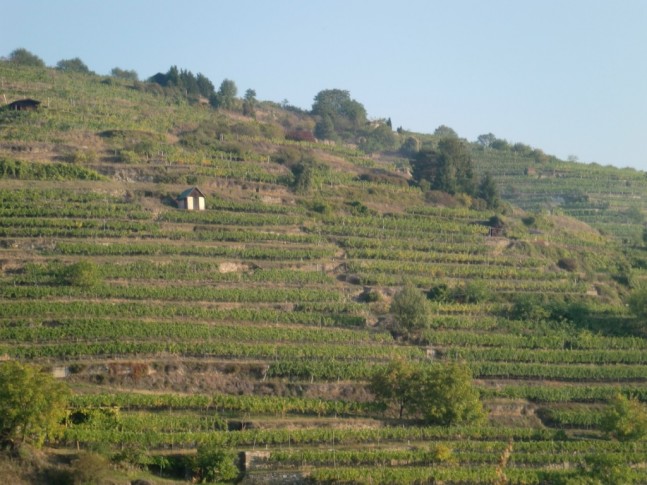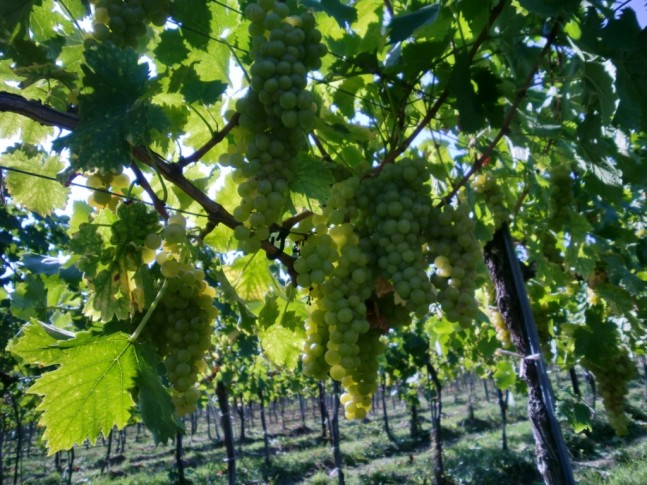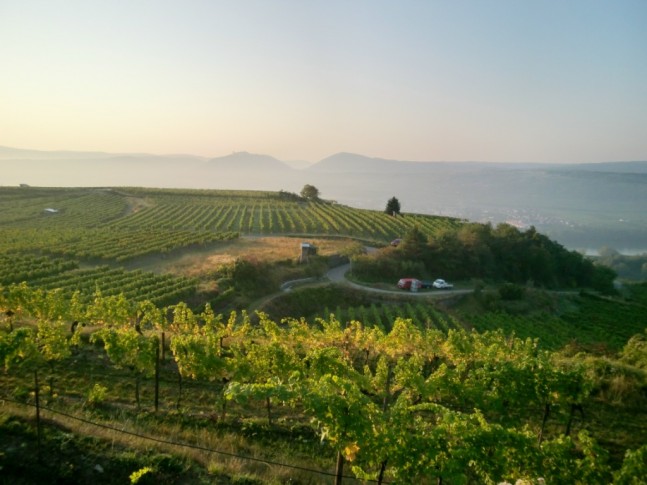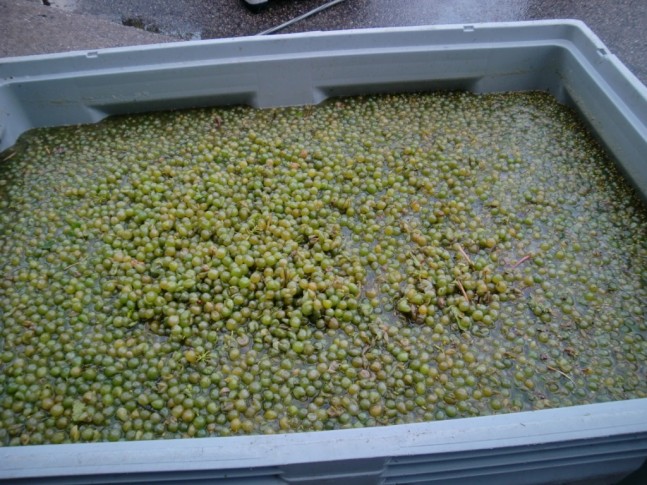Our indefatigable and studious sommelier, Shalom, is deep amongst the vines and rolled up his sleeves to do vintage at Undhof Salomon, in Krems, Austria, under the tutelage of the legendary Dr Bertold Salomon. Shalom is a dedicated student of wine nearly completed his WSET exams and taking on a Wine MBA next year, and in my estimation, a future Master of Wine in the making.
He has committed to writing a blog throughout his time at the Salomon winery and vineyards, although this might well be ambitious as I know how demanding the work schedule can be and when the day/night is done, all you want to do is collapse. Anyway, the most important facet is Shalom is getting some strategic hands-on experience in Austria and building on his strong repertoire of vintage and regional wine experiences.
Day 1 – 26/09/11
Gruner Veltliner was racked and perlite was added. Even before ferment, it already had some of those pepper smells. Mask needed to be put on as OSHC. It went through plate filters. Problems persisted in the filters but were fine once pressure was re-adjusted. Juice tasted fantastic with all the pepperiness before ferment.
Zweigelt came in and was pressed at 0.2-0.8 bar before being pressed to 2 bars. Both free run and pressing were separated and put into different tanks. It had very good physiological ripeness such that the stalks were not green in taste. The pips were very bitter though. To test for acid, Zweigelt was de-colourised with PVPP beforetitration to see the endpoint
The Muller Thurgau came in. It tasted beautifully lemon scented, citrus, good acid and juicy. The juice is looking good so far. The pressing of it commences tomorrow. Tomorrow, I shall be picking.
Day 2 27/09/11
The picking commenced at 7.am. Muller Thurgau was picked first. It was fascinating to see the vines being planted on terraces like the Patamares in Portugal. Terraced vineyards supported by schist are abundant all over Kremstal. The vines were randomly planted and the old Austrian bloke whom I nicknamed “the General” pointed out to us which were the Muller’s we had to pick and which Riesling vines we had to not touch. “The General”, despite his age, was nimble with his pair of secateurs when it came to cutting the grapes off the vines.

Salomon Pfaffenberg vineyard - Krems
As I was picking, I noticed that the out rows of the terraced vineyard had more sunburn on the leaves than the inner row. The inner row had more shade and thus their grapes tasted less sweet. The vines were quite neat and not sprawling over the place compared to some vineyards I have seen in Australia. A three-wire VSP system is used and each vine is cane-pruned. The Muller is quite a fruitful vine and the bunches produced were the size of a man’s palm or even more. The vines are planted at around 600 m above sea level with most of the rows being in the North-South orientation. It was about 24 degree Celsius in the morning.
Some of the bunches were affected by rot and had turned purple. This purple and shriveled grapes are usually what you want to avoid as they have a sour and rotten taste that will ruin the flavors of the healthy grapes when the whole lot is crushed together. From tasting it, I knew that a small amount of it would be sufficient to turn the grape must into something wicked. Another thing to avoid is unripe grapes too. You can tell from looking at the grapes and finding that the sunlight is not making the grapes translucent, but green. Unripe grapes have lots of acid in it and little flavor. I also found that small berries the size of your pinky’s fingernail tends to be sweeter and more flavourful compared to berries the size of your thumb’s fingernails.
Unlike the vineyards in Bordeaux, I found the height from the ground to the crown of the vine is about 4 feet. In Bordeaux and Switzerland, it is usually about 1 feet above the ground. Although this makes picking easy without the need to squat, I found that it also meant I had to be careful placing the grapes in the buckets as the grapes could puncture easily and when the juice starts oozing out, oxidation will be the enemy. In many ways, this experience has taught me that regardless of hand-picking out machine harvested, the most important factor to make great wine is to have control over the handling and transportation of the grapes so that it reaches the winery in perfect condition – unraptured skins, whole berries, disease-free, ripe, and cold. I suppose this is why sorting of individual berries is so important in making great wine. Getting rid of all the material other than healthy grapes is a time-consuming process that requires lots of experienced labour but it will make a difference in the quality of the wine.

Salomon Vineyard - about to pick Muller grapes
We used buckets which can store about 10 kg of grapes and when the buckets were full, we would dump the grapes into a larger bin. There are lots of logistics involved in transporting the bins of grapes and the grape-pickers. As we picked the grapes and moved further away from the bins, someone had to follow us with a fork lift to take the bins closer to our picking location so that we wouldn’t make long trips of lugging heavy buckets of grapes.
Strangely enough, I would expect the grapes to be sulphured in the bins once it is picked instead of sulphuring it before crushing and de-stemming, which can be a while. Some wineries in Australia like to powder their grapes with sulphur before picking but it doesn’t seem to be the practice here in Austria. Interestingly, the whole team of pickers was men except for one. It takes about 10 people to pick up to 15 bins of grapes in 4 hours.
I found the sun here in Austria to be milder than Australia. It only started to warm up at 10 a.m. and reached the peak at 3 p.m. We went to different parts of Kremstal to pick other grapes like Gelber Muskateller (Muscat blanc à petits grains), Pinot blancand Neuburger (a crossing between Sylvaner and Roter Veltliner). Gelber means yellow in German and it makes a lot of sense as there is a slight bronzing on the skin of the grape. It tastes significantly different from other grapes as its berries taste like lychee. This grape is usually bottled on its own but some of it is kept aside for blending into Rieslings to give it more aromatics. They are not blended with Gruner as an aromatic gruner is not the style that the region is known for.

Salomon Vineyards
By the time we picked the Pinot Blanc, it was already 36 degrees Celsius. I was told that the Pinot Blanc would be used to make either a straight varietal wine or used in the blending of sparkling wine. Neuburger is another grape used in blends. It is quite a neutral flavoured grape and small proportions of it are used to reduce the hardness of Rieslings which comes from the high acid.The clones of Neuburger which we picked are not the best. The grapes were conical shaped and very hard to pick. The bunches were small and tight which contributed to lots of botrytis. Moreover, it was hard to get a clean cut to separate the grapes from the shoots as the berries covered the stems and you could not see which part of the cane were the bunches attached to. It stuck me that choosing the right clones of grapes and canopy management to prevent diseases were very important in viticulture.
Pectin Enzymes were added to the Zweigelt and a chainsaw-like machine was being inserted into the tank. The machine works as a sort of mixer to mix the enzymes through the juice. Gelatin and carbon were also added. Ferment has started on the Gruner. As for the Muskateller, PMS and enzymes were added. The Muskateller was de-stemmed and crushed. Sulphur was added and it was left to soak overnight with the skins.

Salomon vintage - Muskateller soaking overnight on skins
Day 3 28/09/2011
More Gruner came in today. The press is working overtime to get all the grapes pressed. I can’t imagine what would happen if it broke down in the middle of vintage. We already had the fork lift break down for an hour and had to get it back up through communication with the mechanic over the phone.
Both thefree run and pressings of Gruner are being fermented at 16 degrees while the unfermented Riesling juice is being kept at 14 degrees and the Zweigelt at 13.
I have had the good chance to taste some wines from Weingut Stadt Krems, which is a winery about 15 minutes away by foot. They make beautiful Rieslings and Gruners. There is no Riesling like this in the world which has the balance between minerality and fruit. It is neither overly toasty nor fruity but with the right touch of both. Their reserve wines which are about 1% higher than their Classic wines have beautiful ripeness levels in there. We are looking at about 7.7 g/l of acidity in both of them and about 7 g/l of sugar. Yet, not of the sweetness is over-the-top. Their Pinot Blanc is also delicious. It is a simple to drink wine with vibrant acid and flavours of green apples and pears. It shall be perfect with food as the acidity can cut through thick dishes and yet the flavours of the wine are light enough to not conflict with the food.
Strangely, I don’t seem to see any use of dry ice being put into the tanks to protect them from oxidation while transferring the juice from press to tank. I wonder if the fact that the grapes don’t get a lot of protection from oxidation is what contributes to the balance between fruit and mineral flavours in there. In Australia, sulphuring and adding dry ice is very common and there seem to be an oxygen aversion among winemakers. Down here in Austria is so significantly different in the way they handle the grapes and juice. Perhaps that is why their wines are not overtly fruity or is it perhaps that the loess soil contributes to the balance of flavours in the wine? After all, loess is a mixture of clay and sand along with calcium carbonate, the very same material found in famous limestone soils in Champagne. Calcium Carbonate is essential in preserving acidity and minerality of the wine, which is reflected here in the Gruner Veltliner and Riesling.
I tasted another Gruner from Fritz and realized that this is a grape which has a lot of similarities to Pinot Gris except for the oiliness on the palate and the distinctly higher acidity. This “white pepper” aroma is really more of a smell in between green and ripe fruit. It is a very different grape from Riesling as Riesling has a more petrol nose and is more mouth-filling and dominant on the finish. Like Riesling, Gruner is really dependent on ripeness levels rather than alcohol levels when I did a comparative tasting between Gruner from Wagram and Dachau. I found a step-up in quality with a riper Gruner compared to the less ripe version of Wachau called Federspiel. Federspiel is a legal term in Wachau for wines between 11.5% to 12.5% alcohol. The reason for the better quality is not just flavor but the missing hard finish in the back due to the phenolics.
Day 4 29/09/2011
The Zweigelt has filtered, fined and cold-stabilized for two days. It was racked and the lees were filtered again once more. Although this filtration means less juice, it is vital to make it as clear as possible before ferment. Acid will be added as the Zweigelt will be used as a sparkling base. The juice from the Zweigelt was beautiful. It is probably the most delicious grape juice I have tasted in my life. Addictively sweet and raspberry in flavour, I couldn’t help but drink it all down from a sample bucket.
The racking of the juice was done with a pump instead of gravity. It was not possible to do it with gravity as the tanks were in a room lower than the pressing area. I suppose designing your winery has to be in line with one’s philosophy in winemaking
|
|
Tweet |






No comments to Vintage blog from Singapore Sommelier, Shalom Chin – at Undhof Salomon, Krems, Austria | Comments Feed
No comments yet
The comments are closed.